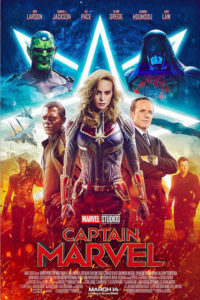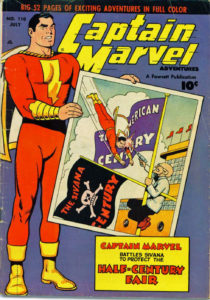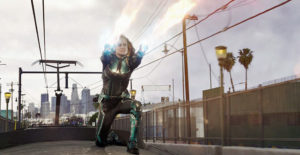
 By Steve Crum
By Steve Crum
Don’t you love it in 1941’s great black and white Republic Pictures serial, The Adventures of Captain Marvel, when young Billy Batson says “Shazam!” and—in a cloud of smoke—changes into the tall, muscular Captain Marvel (Tom Tyler), complete with short cape and bulging biceps?! That was then. NOW is female actress Brie Larson in Captain Marvel, via wide screen color, minus the cape. In fact, her entire costume is day and night opposite the comparatively drab ’41 wardrobe. So is her persona, including her powers in obliterating the bad guys.
Of the two versions, the original remains the classic. This 2019 take has flashier visuals, but so-so  results. Comparing the two Captains encompasses 79 years of a hodgepodge of Captain Marvel makeovers in comic books, TV shows, and movies. Capsulizing Captain Marvel’s history, since Fawcett comic books created the character in 1939, is a daunting task. Bear with me.
results. Comparing the two Captains encompasses 79 years of a hodgepodge of Captain Marvel makeovers in comic books, TV shows, and movies. Capsulizing Captain Marvel’s history, since Fawcett comic books created the character in 1939, is a daunting task. Bear with me.
The metamorphosis from Billy Batson/Captain Marvel to Carol Danvers/Captain Marvel covers a long list of legal suits, copyright intrusions, and Hollywood one-upmanship. Fawcett comics first had Captain Marvel, but DC Comics sued and won, claiming Superman had essentially been ripped off. In the late 1960s, Marvel Comics legally resuscitated the Captain Marvel trademark. Then the superhero underwent no less than seven incarnations, from the alien military officer Captain Mar-Vell, in 1967, to monikers like Monica Rambeau, Genis-Vell, Phyla-Well, Khn’nr, Noh-Varr, and finally…Carol Danvers. (And don’t even confuse this Danvers with DC’s Supergirl and her secret identity, Linda Danvers. We are talking the Marvel Universe here.)
Cut to Larson’s Danvers in Captain Marvel, opening in theaters today, as she explores her meaning and purpose in life by way of codirectors Anna Boden and Ryhan Bleck—who also helped with the screenplay. This is Captain Marvel’s origin story, a sub-genre fans have come to expect thanks to the explosion of superhero movies during the last three decades. As such, Captain Marvel is the first Marvel-based superhero film to feature a woman as the single lead. 1984’s Supergirl holds that distinction for the DC Universe movies.

In a synopsis nutshell, Carol Danvers is having nightmares due to her past as a U. S. Air Force fighter pilot and member of a secret unit called Kree. An accident has imbued her with superhuman strength, energy protection, and the ability to fly like Iron Man—but without need for any special suit. One of the problems with Captain Marvel is just that: the redundant flying sequences are staged more impressively in the Iron Man series.
 At this point in the comic book movie genre, comparisons are unavoidable.
At this point in the comic book movie genre, comparisons are unavoidable.
The fun of Captain Marvel is not so much Danvers/Marvel, but her pal Nick Fury, portrayed by the ubiquitous Samuel L. Jackson. He is encountered in a trip back in time to 1995, before he became the Director of S.H.I.E.L.D. He’s just an agent now, along with his sidekick, Phil Coulson (Clark Gregg). Danvers is chasing bad guy shape-shifter Talos (Ben Mendelsohn), through a strip mall. (Blockbuster Video and Radio Shack stores are part of the nostalgic landscape.) Fury and his unit arrive on the scene after reports of violence. It is not long before Danvers dazzles Fury with her superpowers. When she and Fury eventually team, the movie sparks alive.
 As if the plot isn’t convoluted enough, there are additional characters Maria Rambeau (Lashana Lynch)—an old friend and fellow pilot; and Annette Bening as the Supreme Intelligence/Mar-Vell/Dr. Wendy Lawson. She is the collective intelligence of the greatest minds of the Krees, and ruler of their empire. Factor in Danvers’ mentor, Yon-Rogg (Jude Law), a good-bad guy that just might confuse you like he did me. In fact, most of Captain Marvel befuddled this casual fan of the Marvel Universe.
As if the plot isn’t convoluted enough, there are additional characters Maria Rambeau (Lashana Lynch)—an old friend and fellow pilot; and Annette Bening as the Supreme Intelligence/Mar-Vell/Dr. Wendy Lawson. She is the collective intelligence of the greatest minds of the Krees, and ruler of their empire. Factor in Danvers’ mentor, Yon-Rogg (Jude Law), a good-bad guy that just might confuse you like he did me. In fact, most of Captain Marvel befuddled this casual fan of the Marvel Universe.
But I did love the inclusion of the the stray cat, Goose, adopted by Nick Fury. Cuteness aside, beware his puddy tat mouth and claws. Enough said.
Captain Marvel seems more apt to shine among a group like the Avengers, a point suggested at the conclusion of the end credits. Remain seated if that interests you.
=====
 CAPTAIN MARVEL BITS:
CAPTAIN MARVEL BITS:
•Both Samuel L. Jackson and Clark Gregg appear 20+ years younger, believably so. The amazing transformation was done frame-by-frame, using computer digitalizing, great makeup, and wigs.
•Do not confuse Captain Marvel with the 1970s kid show, Shazam! THAT one was based upon the original Fawcett Captain Marvel. Just to make things more bananas, the DC version of Shazam! will be released next month.
=====
GRADE, Based upon A to F Scale: C+
